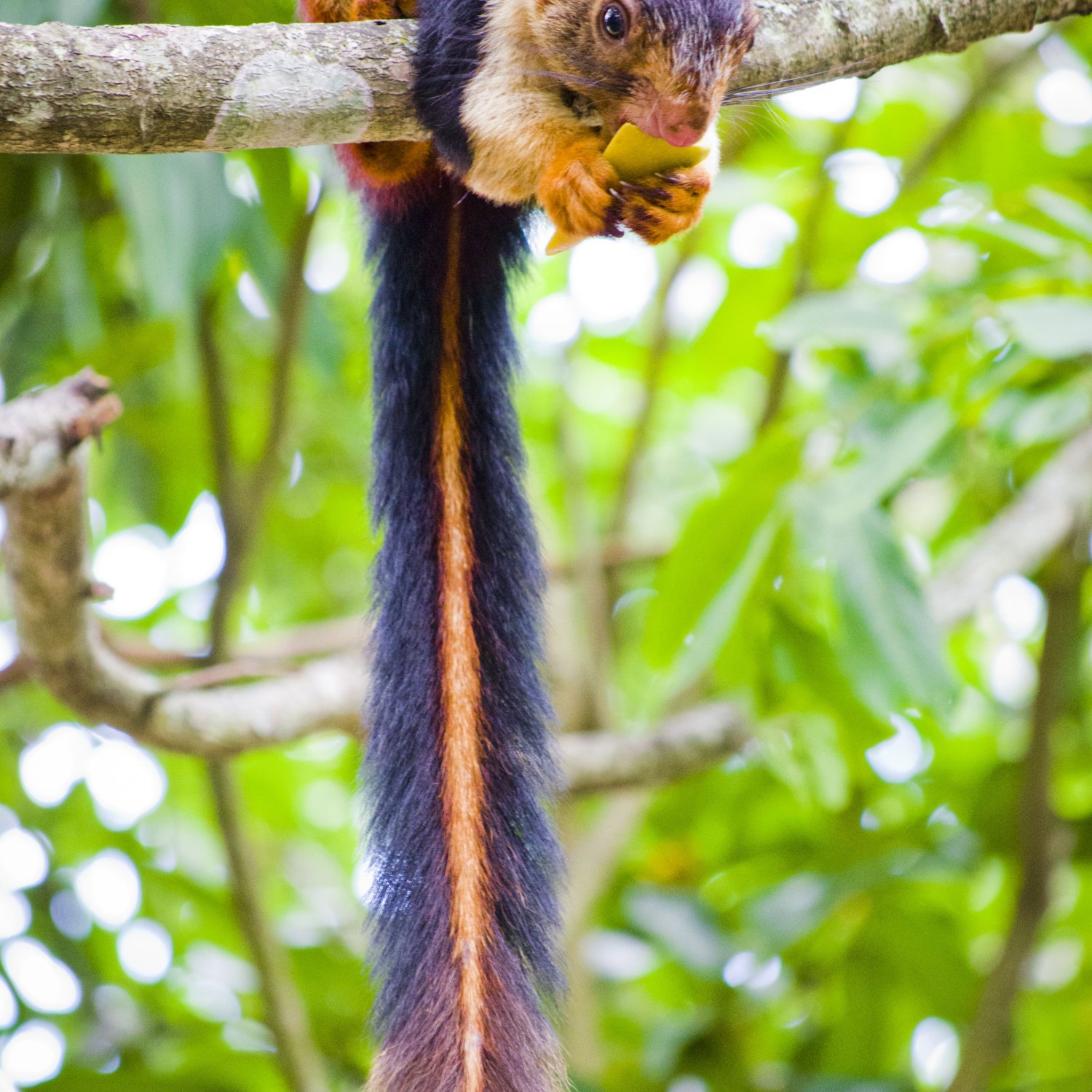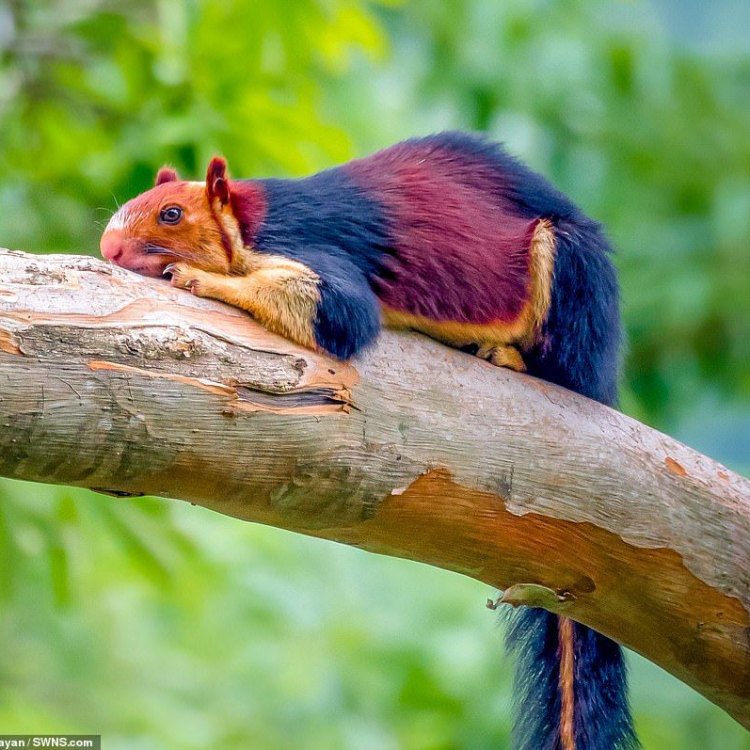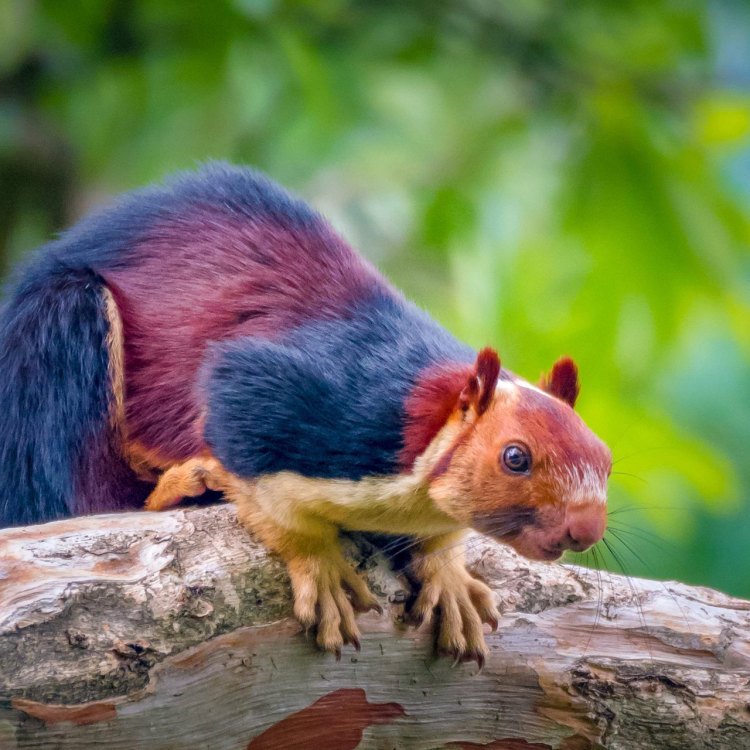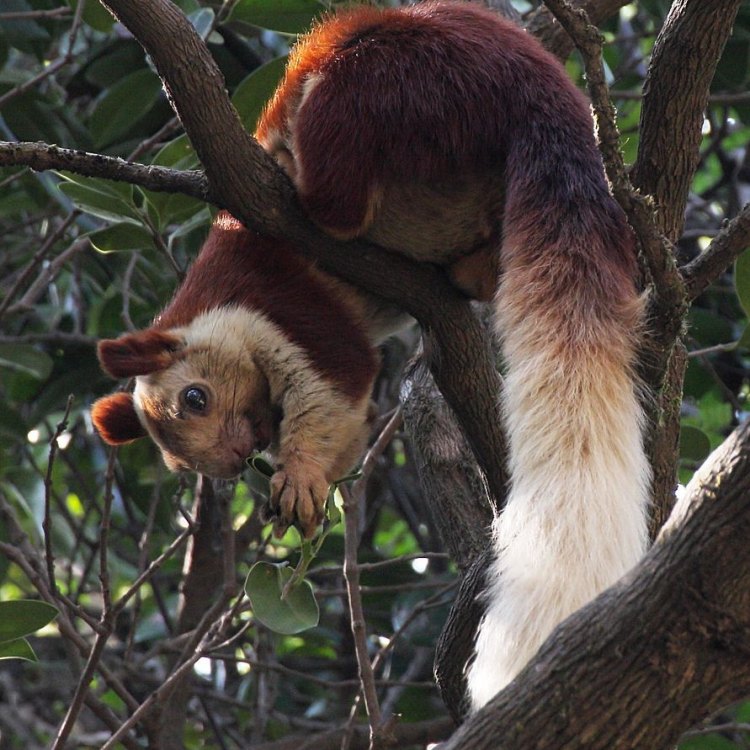
Indian Giant Squirrel
25 to 45 cm
The Indian Giant Squirrel, also known as the Malabar Giant Squirrel, is a stunning creature found in the Southern and Western Ghats of the Indian subcontinent. This charismatic animal belongs to the Sciuridae family and is known for its large and robust body shape, measuring 25 to 45 cm in length. Its unique appearance makes it a must-see for nature lovers and wildlife enthusiasts.
Animal Details Summary:
Common Name: Indian Giant Squirrel
Kingdom: Animalia
Habitat: Tropical and subtropical forests
The Indian Giant Squirrel: A Majestic Creature of the Forest
In the lush, green forests of India, Nepal, Bhutan, and Sri Lanka roams a majestic creature that is often overlooked due to its larger, more popular cousins. Meet the Indian Giant Squirrel, also known as Ratufa indica, a unique and fascinating species that inhabits the tropical and subtropical forests of Southern and Western Ghats.As its name suggests, the Indian Giant Squirrel is a large and robust creature, measuring between 25 to 45 cm in length. But its size is not the only thing that sets it apart; its striking reddish-brown to dark brown coloration and its omnivorous feeding method make it a truly remarkable animal to observe in its natural habitat Indian Giant Squirrel.
In this article, we will delve deeper into the characteristics and habits of the Indian Giant Squirrel, exploring its habitat, behavior, and role in the ecosystem.
Taxonomy and Classification
Let us begin with the basics. The Indian Giant Squirrel belongs to the Animalia kingdom, Chordata phylum, Mammalia class, and Rodentia order. Its scientific name, Ratufa indica, comes from combining the Latin words "ratufa," which means squirrel, and "indica," which refers to its native region, India.Ratufa indica belongs to the Sciuridae family, which also includes other well-known species like squirrels, chipmunks, and marmots. It is closely related to the Malayan Giant Squirrel and the Sri Lankan Giant Squirrel, with all three species belonging to the Ratufa genus.
The Indian Giant Squirrel's classification may seem like just a bunch of scientific jargon, but it is essential to understand its taxonomic position to comprehend its behavior and role in the ecosystem fully.
Habitat and Geographical Distribution
The Indian Giant Squirrel is a primarily arboreal species, which means it lives and spends most of its time in trees. It can be found in tropical and subtropical forests, including evergreen, deciduous, and rainforests, as well as secondary forests and plantations Irish Setter.However, despite its name, the Indian Giant Squirrel is not limited to India alone. It can also be found in Nepal, Bhutan, and Sri Lanka, which make up its geographical distribution range. In India, it is largely found in the states of Kerala, Karnataka, Tamil Nadu, and Andhra Pradesh, particularly in the Nilgiri Biosphere Reserve, Anamalai Tiger Reserve, and Silent Valley National Park.
In Nepal, the Indian Giant Squirrel is limited to the Terai region, while in Bhutan, it is mostly found in the foothills of the Himalayas. In Sri Lanka, it can be spotted in the lowland forests and the Central and Southern Hills.
This wide distribution range is a testament to the adaptability of the Indian Giant Squirrel and its ability to thrive in different environments.
Appearance and Body Shape
One of the most striking features of the Indian Giant Squirrel is its coloration. As mentioned earlier, it ranges from reddish-brown to dark brown, with a lighter underside. This coloration is essential for camouflage, allowing the squirrel to blend in with the bark of trees and avoid detection by predators.The Indian Giant Squirrel also has a distinct, large, and bushy tail that can be almost as long as its body. This tail serves multiple purposes, from communication to keeping balance while leaping through trees.
As its name suggests, the Indian Giant Squirrel is a large and robust animal, with a body length of 25 to 45 cm. It also has a relatively long and muscular nose, small ears, and sharp claws that help it grip onto trees while foraging for food.
Feeding Method and Diet
The Indian Giant Squirrel is an omnivorous species, which means it feeds on both plants and animals. Its diet primarily consists of fruits, nuts, seeds, and insects. It is also known to occasionally feed on eggs and small vertebrates like lizards and birds.Being an arboreal species, the Indian Giant Squirrel is well adapted for its primarily plant-based diet. Its sharp claws allow it to climb trees with ease, while its powerful jaws and long incisors help it crack open hard nuts and fruits.
This feeding method also plays a crucial role in maintaining the balance of the forest ecosystem. As an important seed disperser, the Indian Giant Squirrel helps in the regeneration of forests and supports the growth and diversity of plant species.
Behavior and Social Structure
The Indian Giant Squirrel is an extremely agile and active creature, spending most of its time foraging for food and moving between trees. It is known for its impressive leaping ability, with some individuals being able to jump up to 20 feet in one go.They are also highly territorial animals, with individuals marking their territory using scent glands. Despite their territorial nature, Indian Giant Squirrels are also known to form small groups called dreys, composed of males, females, and young offspring. These groups help in mutual protection, especially against predators.
One fascinating behavior of the Indian Giant Squirrel is its ability to rotate its hind legs, enabling it to descend trees headfirst. This unique adaptation allows it to escape predators quickly and navigate through the forest effortlessly.
Conservation Status and Threats
According to the International Union for Conservation of Nature (IUCN), the Indian Giant Squirrel is listed as a species of "Least Concern" in terms of conservation status. This means that, currently, it is not facing any significant threats or population decline.However, like many other wild animal species, the Indian Giant Squirrel is also facing a number of threats, mainly due to habitat loss and fragmentation. As human populations continue to grow, forests are being cleared for agriculture, logging, and urban development, which threatens the survival of these animals.
Additionally, the Indian Giant Squirrel is also hunted for its meat and fur, and often falls victim to roadkill and electrocution from electrical wires. Conserving its habitat and creating wildlife corridors can help mitigate these threats and ensure the survival of this important forest dweller.
The Indian Giant Squirrel and Traditional Beliefs
The Indian Giant Squirrel holds a special place in the traditional beliefs and culture of the tribal communities in the Western Ghats of India. In these tribes, it is considered a sacred animal and is often depicted in their dances, songs, and rituals.It is believed that the Indian Giant Squirrel is an incarnation of Lord Rama's twin brother, Lakshmana, who was known for his agility and leaping abilities. In these tribal communities, the squirrel is also considered a symbol of good luck and prosperity.
This cultural and religious significance of the Indian Giant Squirrel has helped in its conservation efforts, as it is revered by the people living in close proximity to its habitat.
Final Thoughts
In conclusion, the Indian Giant Squirrel is a truly remarkable creature that often goes unnoticed. Its large size, striking coloration, and unique behaviors make it a captivating animal to observe in the wild.While its population and conservation status may seem stable currently, it is crucial to continue efforts towards conserving its habitat and mitigating potential threats. As human populations continue to expand, it is our responsibility to ensure the survival of this majestic creature and preserve the biodiversity of our forests.

Indian Giant Squirrel
Animal Details Indian Giant Squirrel - Scientific Name: Ratufa indica
- Category: Animals I
- Scientific Name: Ratufa indica
- Common Name: Indian Giant Squirrel
- Kingdom: Animalia
- Phylum: Chordata
- Class: Mammalia
- Order: Rodentia
- Family: Sciuridae
- Habitat: Tropical and subtropical forests
- Feeding Method: Omnivorous
- Geographical Distribution: India, Nepal, Bhutan, and Sri Lanka
- Country of Origin: India
- Location: Southern and Western Ghats
- Animal Coloration: Reddish-brown to dark brown
- Body Shape: Large and robust
- Length: 25 to 45 cm

Indian Giant Squirrel
- Adult Size: 15 to 35 cm
- Average Lifespan: 8 to 10 years
- Reproduction: Sexual
- Reproductive Behavior: Polygynous
- Sound or Call: High-pitched chirping calls
- Migration Pattern: Non-migratory
- Social Groups: Solitary and territorial
- Behavior: Diurnal and arboreal
- Threats: Habitat loss, deforestation, and hunting
- Conservation Status: Near Threatened
- Impact on Ecosystem: Seed dispersers
- Human Use: None
- Distinctive Features: Large size and long bushy tail
- Interesting Facts: Indian Giant Squirrels can leap up to 6 meters between trees.
- Predator: Birds of prey, snakes, and large mammals

Ratufa indica
The Incredible Indian Giant Squirrel: A Fascinating Creature of the Forest
In the lush forests of India, there is a creature that stands out with its striking colors and impressive size. The Indian Giant Squirrel, also known as the Malabar Giant Squirrel, is a unique and fascinating species that has captured the attention of many nature enthusiasts. With its distinctive features and interesting behaviors, this squirrel is truly a remarkable creature that deserves to be explored.Let's dive into the world of the Indian Giant Squirrel and discover what makes it so special PeaceOfAnimals.Com.
Physical Appearance and Size
The Indian Giant Squirrel is a species of squirrel that is native to India. It belongs to the genus Ratufa, which includes other species of giant squirrels found in Southern and Southeast Asia. As its name suggests, this squirrel is known for its impressive size. It can grow up to 35 cm (14 inches) in length, making it one of the largest squirrels in the world.One of the most striking features of this squirrel is its long, bushy tail that can grow up to 2 feet in length. The tail is often longer than the body itself, giving this squirrel an elegant appearance. The tail is also used for balance and communication, as it helps the squirrel to navigate and make high-pitched chirping sounds to communicate with other squirrels.
The fur of the Indian Giant Squirrel is another unique aspect of its physical appearance. It is a vibrant mix of colors, including shades of brown, orange, and black Indigo Snake. The top of the body is usually dark brown, while the underside is lighter in color. This coloration helps the squirrel to blend into its surroundings, making it difficult for predators to spot it.
Behavior and Lifestyle
The Indian Giant Squirrel is a diurnal and arboreal species, meaning that it is most active during the day and lives exclusively in trees. It is a solitary and territorial animal, and each individual has its own territory that it defends against other squirrels. These territories can range from 2 to 4 hectares in size, depending on the availability of food and resources.This species of squirrel is also known for its incredible jumping abilities. It can leap up to 6 meters (20 feet) between trees, using its strong hind legs and long tail as a rudder. This agile and acrobatic behavior helps the squirrel to navigate through the dense forest canopy in search of food.
The Indian Giant Squirrel is also a polygynous species, meaning that males have multiple female partners. The breeding season usually falls between October and February, and during this time, males will compete with each other for the attention of females. Once mated, the female will build a nest in a tree cavity or leafy nest made out of twigs, leaves, and branches. After a gestation period of about 28 days, the female gives birth to two to three young, which she will care for until they are independent at around three months old.
Threats and Conservation Status
Despite being an impressive and fascinating creature, the Indian Giant Squirrel faces numerous threats that affect its population. The primary threat is habitat loss due to deforestation and human activities. With increasing urbanization and expansion of agricultural lands, the natural habitat of these squirrels is rapidly declining. This not only reduces the available space for the squirrels to live in, but it also affects their food sources and breeding patterns.Hunting is another significant threat to the Indian Giant Squirrel. These squirrels are often hunted for their meat and traditional medicines, which falsely claim to have healing properties. As a result, their population is dwindling in some areas, and they are classified as Near Threatened by the International Union for Conservation of Nature (IUCN).
Ecological Importance
The Indian Giant Squirrel plays a vital role in its ecosystem as a seed disperser. As they move through the forest canopy, they collect seeds and nuts, which they bury in the ground or store in tree cavities for later consumption. Some of these seeds are forgotten and left to germinate, ensuring the growth of new plants and trees. This makes the Indian Giant Squirrel an essential agent in the regeneration and maintenance of the forest.Moreover, the presence of these squirrels in an area is an indicator of a healthy forest ecosystem. Their decline signifies an imbalance in the ecosystem, which can have a cascading effect on other species and the environment as a whole.
Human Use and Conservation Efforts
Unlike other species, the Indian Giant Squirrel does not have any direct use for humans, such as providing food or fur. However, they contribute to the economy through wildlife tourism. Many people are drawn to their stunning colors and unique behaviors, making them a popular subject for nature lovers and photographers.To protect this magnificent creature, conservation efforts are being implemented in parts of India where the Indian Giant Squirrel population is declining. These efforts include establishing protected areas, educating local communities about the importance of conservation, and promoting sustainable use of resources.
Unique Features and Fun Facts
The Indian Giant Squirrel is undoubtedly a fascinating creature with its striking appearance and interesting behaviors. To recap, let's take a look at some of its unique features and fun facts:- One of the largest squirrels in the world, growing up to 35 cm (14 inches) in length
- Sporting a vibrant mix of colors, including shades of brown, orange, and black
- Known for its impressive jumping abilities, leaping up to 6 meters (20 feet) between trees
- A diurnal and arboreal species, meaning it is active during the day and lives exclusively in trees
- Agile and acrobatic behavior helps it navigate through the dense forest canopy
- It has a high-pitched chirping call to communicate with other squirrels
- The male has multiple female partners and is polygynous
- Females give birth to two to three young, which they care for until they are independent at three months old
- Faces threats such as habitat loss and hunting, leading to a Near Threatened conservation status
- Plays a vital role in the ecosystem as a seed disperser, contributing to the growth and maintenance of the forest
- A popular subject for nature enthusiasts and photographers
- Hunted for its meat and falsely believed to have healing properties
- Does not have any direct use for humans, but contributes to the economy through wildlife tourism
In Conclusion
The Indian Giant Squirrel is a truly incredible creature that has captured the hearts and minds of many with its unique features and behaviors. From its stunning colors and impressive size to its acrobatic abilities and important role in the ecosystem, this squirrel is a true wonder of nature. However, with threats like habitat loss and hunting, it is crucial to continue conservation efforts to protect this magnificent species and ensure its survival for future generations to appreciate.

The Indian Giant Squirrel: A Majestic Creature of the Forest
Disclaimer: The content provided is for informational purposes only. We cannot guarantee the accuracy of the information on this page 100%. All information provided here may change without prior notice.












